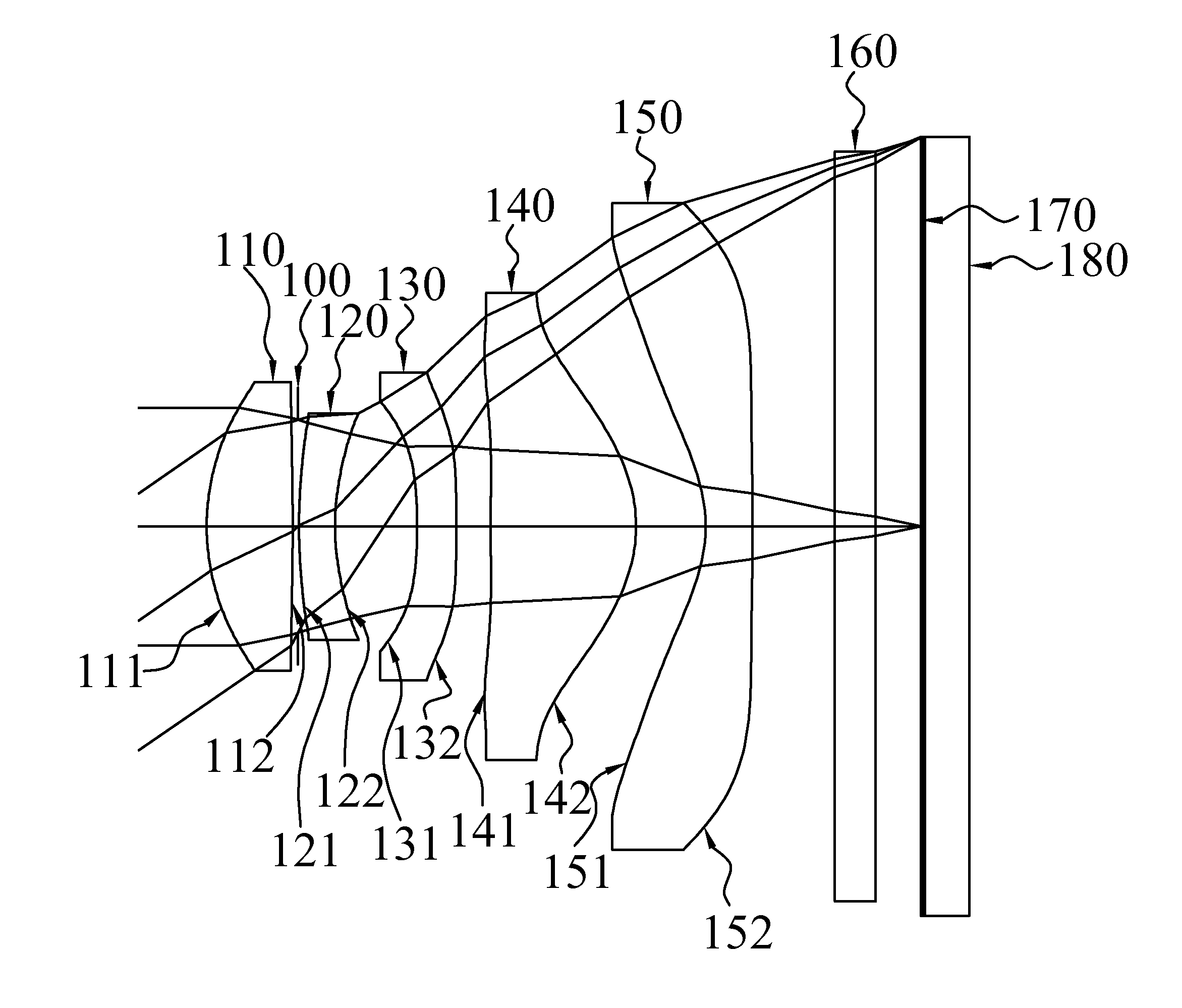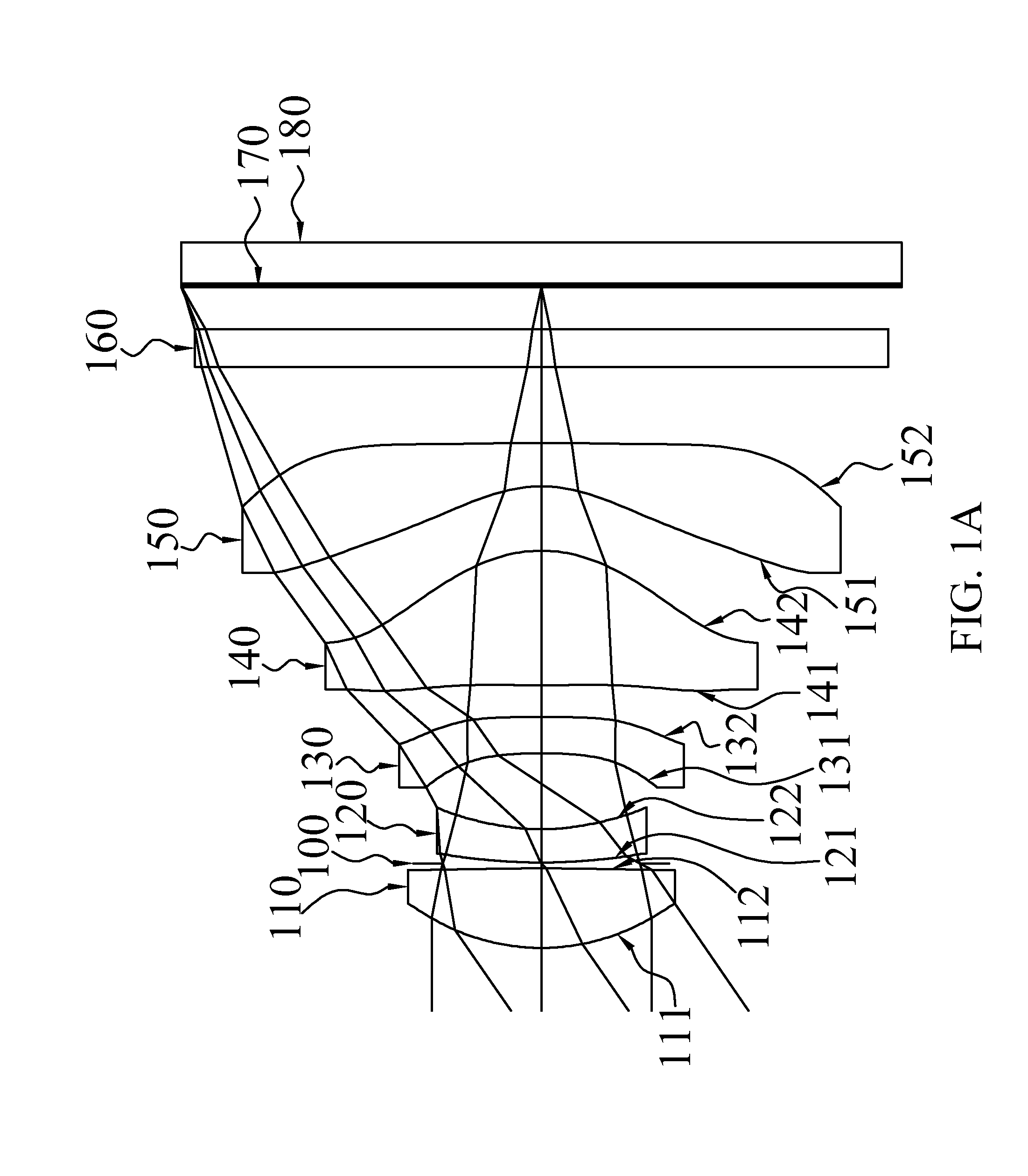Optical Imaging Lens Assembly
a technology of optical imaging and lens assembly, which is applied in the field of can solve the problems of high manufacturing cost, inability to shorten the total length of the optical system, and inability to easily make aspheric lenses by glass, so as to facilitate the reduction of rear focal length, shorten the total length of the optical imaging lens assembly, and improve the effect of aberration correction
- Summary
- Abstract
- Description
- Claims
- Application Information
AI Technical Summary
Benefits of technology
Problems solved by technology
Method used
Image
Examples
first preferred embodiment
[0062]With reference to FIGS. 1A and 1B for a schematic view and a series of aberration curves of an optical image lens assembly in accordance with the first preferred embodiment of the present invention respectively, the optical imaging lens assembly comprises five non-cemented lenses with refractive power, an aperture stop 100 and an IR-filter 160. More specifically, the optical imaging lens assembly, sequentially arranged from an object side to an image side along an optical axis, comprises: a plastic first lens element 110 with positive refractive power, having a convex object-side surface 111 and a convex image-side surface 112, and both object-side surface 111 and image-side surface 112 thereof being aspheric; an aperture stop 100; a plastic second lens element 120 with negative refractive power, having a convex object-side surface 121 and a concave image-side surface 122, and both object-side surface 121 and image-side surface 122 thereof being aspheric; a plastic third lens ...
second preferred embodiment
[0066]With reference to FIGS. 2A and 2B for a schematic view and a series of aberration curves of an optical image lens assembly in accordance with the second preferred embodiment of the present invention respectively, the optical imaging lens assembly comprises five non-cemented lenses with refractive power, an aperture stop 200 and an IR-filter 260. More specifically, the optical imaging lens assembly, sequentially arranged from an object side to an image side along an optical axis, comprises: a plastic first lens element 210 with positive refractive power, having a convex object-side surface 211 and a convex image-side surface 212, and both object-side surface 211 and image-side surface 212 thereof being aspheric; an aperture stop 200; a plastic second lens element 220 with negative refractive power, having a concave object-side surface 221 and a concave image-side surface 222, and both object-side surface 221 and image-side surface 222 thereof being aspheric; a plastic third len...
third preferred embodiment
[0070]With reference to FIGS. 3A and 3B for a schematic view and a series of aberration curves of an optical image lens assembly in accordance with the third preferred embodiment of the present invention respectively, the optical imaging lens assembly comprises five non-cemented lenses with refractive power, an aperture stop 300 and an IR-filter 360. More specifically, the optical imaging lens assembly, sequentially arranged from an object side to an image side along an optical axis, comprises: a plastic first lens element 310 with positive refractive power, having a convex object-side surface 311 and a convex image-side surface 312, and both object-side surface 311 and image-side surface 312 thereof being aspheric; an aperture stop 300; a plastic second lens element 320 with negative refractive power, having a concave object-side surface 321 and a convex image-side surface 322, and both object-side surface 321 and image-side surface 322 thereof being aspheric; a plastic third lens ...
PUM
 Login to View More
Login to View More Abstract
Description
Claims
Application Information
 Login to View More
Login to View More - R&D
- Intellectual Property
- Life Sciences
- Materials
- Tech Scout
- Unparalleled Data Quality
- Higher Quality Content
- 60% Fewer Hallucinations
Browse by: Latest US Patents, China's latest patents, Technical Efficacy Thesaurus, Application Domain, Technology Topic, Popular Technical Reports.
© 2025 PatSnap. All rights reserved.Legal|Privacy policy|Modern Slavery Act Transparency Statement|Sitemap|About US| Contact US: help@patsnap.com



